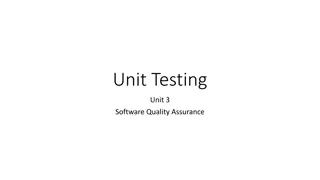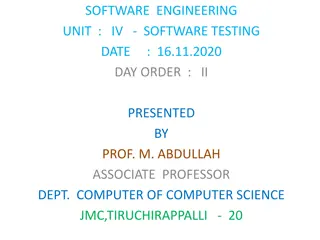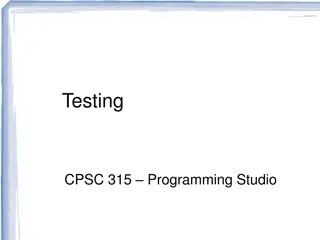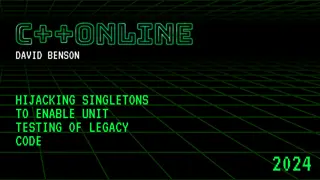A Comprehensive Guide to Unit Testing in Software Engineering
Unit testing in software engineering is essential for ensuring the reliability and functionality of individual units of source code. This guide covers the concepts of unit testing, its implementation roadmap, planning considerations, and detailed techniques for performing method testing effectively.
Download Presentation

Please find below an Image/Link to download the presentation.
The content on the website is provided AS IS for your information and personal use only. It may not be sold, licensed, or shared on other websites without obtaining consent from the author. Download presentation by click this link. If you encounter any issues during the download, it is possible that the publisher has removed the file from their server.
E N D
Presentation Transcript
UNIT TESTING, INTEGRATION TESTING AND SYSTEM TESTING Testing and System Implementation
TESTING: THE BIG PICTURE 3. System tests 2. Integration tests Module combination 1. Unit tests Module Function
WHAT IS UNIT TESTING? In computer programming, unit testing is a method by which individual units of source code are tested to determine if they are fit for use. A unit is the smallest testable part of an application. In procedural programming a unit may be an individual function or procedure. In object-oriented programming a unit is usually a method. Unit tests are created by programmers or occasionally by white box testers. 4
PLAN FOR UNIT TESTING 1. Decide on the philosophy for unit testing individual engineer responsible (common)? reviewed by others? designed & performed by others? 2. Decide what / where / how to document individual s personal document set (common)? how / when to incorporate into other types of testing? incorporate in formal documents? use tools / test utilities? 3. Determine extent of unit testing (i.e., in advance). do not just test until time expires prioritize, so that important tests definitely performed 4. Decide how and where to get the test input 5. Estimate the resources required use historical data if available 6. Arrange to track time, defect count, type & source
Perform Method Testing 1/2 One way to ... 1. Verify operation at normal parameter values (a black box test based on the unit s requirements) 2. Verify operation at limit parameter values (black box) 3. Verify operation outside parameter values (black box) 4. Ensure that all instructions execute (statement coverage) 5. Check all paths, including both sides of all branches (decision coverage) 6. Check the use of all called objects 7. Verify the handling of all data structures 8. Verify the handling of all files
Perform Method Testing 2/2 One way to ... 9. Check normal termination of all loops (part of a correctness proof) 10. Check abnormal termination of all loops 11. Check normal termination of all recursions 12. Check abnormal termination of all recursions 13. Verify the handling of all error conditions 14. Check timing and synchronization 15. Verify all hardware dependencies
RELATING TESTS TO REQUIREMENTS & DESIGN (2) Design GameCharacter Requirements An abstract class with attribute name ... (1) D-Requirements 3.2.EC.1.2 Qualities of Encounter characters Every game character has the same set of qualities. Each quality shall be a non- negative floating point number with at least one decimal of precision. . . . . . . .
(2) Design GameCharacter Requirements An abstract class with attribute name ... Test this class ... ... against this requirement (1) D-Requirements 3.2.EC.1.2 Qualities of Encounter characters Every game character has the same set of qualities. Each quality shall be a non- negative floating point number with at least one decimal of precision. . . . Characters GameCharacter Test this method ... Encounter Characters ... against this requirement EncounterCharacter adjustQuality() RELATING TESTS TO REQUIREMENTS & DESIGN
Applied to ... Unit test Concentration Stamina Results in a zero value? No: Test 1.1 1. Within range Test 1.1.1 etc. Yes: Test 1.2 Partitioning of Range for Unit Testing 1 of 2 Test 1.2.1 etc.
Applied to ... Unit test Concentration Stamina Results in a zero value? No: Test 2.1 2. Outside range Test 2.1.1 etc. Yes: Test 2.2 Partitioning of Range for Unit Testing 2 of 2 Test 2.2.1 etc.
WHY DO WE DO INTEGRATION TESTING? Unit tests only test the unit in isolation Many failures result from faults in the interaction of subsystems Often many Off-the-shelf components are used that cannot be unit tested Without integration testing the system test will be very time consuming Failures that are not discovered in integration testing will be discovered after the system is deployed and can be very expensive.
INTEGRATION TESTING STRATEGY The entire system is viewed as a collection of subsystems (sets of classes) determined during the system and object design. The order in which the subsystems are selected for testing and integration determines the testing strategy Big bang integration (Nonincremental) Bottom up integration Top down integration Sandwich testing Variations of the above
STUBS AND DRIVERS Driver Driver: A component, that calls the TestedUnit Controls the test cases Tested Unit Stub: A component, the TestedUnit depends on Partial implementation Returns fake values. Stub
EXAMPLE : THREE LAYER CALL HIERARCHY A Layer I Layer II D C B Layer III G F E
PROS AND CONS OF BOTTOM UP INTEGRATION TESTING Bad for functionally decomposed systems: Tests the most important subsystem (UI) last Useful for integrating the following systems Object-oriented systems real-time systems systems with strict performance requirements
PROS AND CONS OF TOP-DOWN INTEGRATION TESTING Test cases can be defined in terms of the functionality of the system (functional requirements) Writing stubs can be difficult: Stubs must allow all possible conditions to be tested. Possibly a very large number of stubs may be required, especially if the lowest level of the system contains many methods. One solution to avoid too many stubs: Modified top-down testing strategy Test each layer of the system decomposition individually before merging the layers Disadvantage of modified top-down testing: Both, stubs and drivers are needed
SANDWICH TESTING STRATEGY Combines top-down strategy with bottom-up strategy The system is view as having three layers A target layer in the middle A layer above the target A layer below the target Testing converges at the target layer How do you select the target layer if there are more than 3 layers? Heuristic: Try to minimize the number of stubs and drivers
PROS AND CONS OF SANDWICH TESTING Top and Bottom Layer Tests can be done in parallel Does not test the individual subsystems thoroughly before integration Solution: Modified sandwich testing strategy
MODIFIED SANDWICH TESTING STRATEGY Test in parallel: Middle layer with drivers and stubs Top layer with stubs Bottom layer with drivers Test in parallel: Top layer accessing middle layer (top layer replaces drivers) Bottom accessed by middle layer (bottom layer replaces stubs)
STEPS IN INTEGRATION-TESTING 1. Based on the integration strategy, select a component to be tested. Unit test all the classes in the component. 2. Put selected component together; do any preliminary fix-up necessary to make the integration test operational (drivers, stubs) 3. Do functional testing: Define test cases that exercise all uses cases with the selected component 4. Do structural testing: Define test cases that exercise the selected component 5. Execute performance tests 6. Keep records of the test cases and testing activities. 7. Repeat steps 1 to 7 until the full system is tested. The primary goal of integration testing is to identify errors in the (current) component configuration.
WHICH INTEGRATION STRATEGY SHOULD YOU USE? Factors to consider Amount of test harness (stubs &drivers) Location of critical parts in the system Availability of hardware Availability of components Scheduling concerns Bottom up approach good for object oriented design methodologies Test driver interfaces must match component interfaces ... ...Top-level components are usually important and cannot be neglected up to the end of testing Detection of design errors postponed until end of testing Top down approach Test cases can be defined in terms of functions examined Need to maintain correctness of test stubs Writing stubs can be difficult
SYSTEM TESTING Functional Testing Structure Testing Performance Testing Acceptance Testing Installation Testing Impact of requirements on system testing: The more explicit the requirements, the easier they are to test. Quality of use cases determines the ease of functional testing Quality of subsystem decomposition determines the ease of structure testing Quality of nonfunctional requirements and constraints determines the ease of performance tests
STRUCTURE TESTING Essentially the same as white box testing. Goal: Cover all paths in the system design Exercise all input and output parameters of each component. Exercise all components and all calls (each component is called at least once and every component is called by all possible callers.) Use conditional and iteration testing as in unit testing.
FUNCTIONAL TESTING Essentially the same as black box testing Goal: Test functionality of system Test cases are designed from the requirements analysis document (better: user manual) and centered around requirements and key functions (use cases) The system is treated as black box. Unit test cases can be reused, but in end user oriented new test cases have to be developed as well.
PERFORMANCE TESTING Stress Testing Stress limits of system (maximum # of users, peak demands, extended operation) Volume testing Test what happens if large amounts of data are handled Configuration testing Test the various software and hardware configurations Compatibility test Test backward compatibility with existing systems Security testing Try to violate security requirements Timing testing Evaluate response times and time to perform a function Environmental test Test tolerances for heat, humidity, motion, portability Quality testing Test reliability, maintain- ability & availability of the system Recovery testing Tests system s response to presence of errors or loss of data. Human factors testing Tests user interface with user
TEST CASES FOR PERFORMANCE TESTING Push the (integrated) system to its limits. Goal: Try to break the subsystem Test how the system behaves when overloaded. Can bottlenecks be identified? (First candidates for redesign in the next iteration Try unusual orders of execution Call a receive() before send() Check the system s response to large volumes of data If the system is supposed to handle 1000 items, try it with 1001 items. What is the amount of time spent in different use cases? Are typical cases executed in a timely fashion?
ACCEPTANCE TESTING Alpha test: Sponsor uses the software at the developer s site. Software used in a controlled setting, with the developer always ready to fix bugs. Beta test: Conducted at sponsor s site (developer is not present) Software gets a realistic workout in target environ- ment Potential customer might get discouraged Goal: Demonstrate system is ready for operational use Choice of tests is made by client/sponsor Many tests can be taken from integration testing Acceptance test is performed by the client, not by the developer. Majority of all bugs in software is typically found by the client after the system is in use, not by the developers or testers. Therefore two kinds of additional tests:























